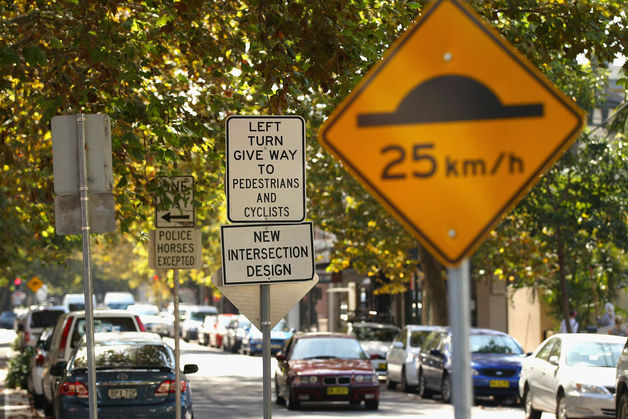The force of the collision launched
cyclist Hans Dean onto the car’s windscreen and hurled him to
the ground, his spine broken and face so bloodied he could
barely see. The Sydney rider is thankful he’s alive.
Cyclist deaths jumped to a 16-year high across Australia
last year and doubled in New South Wales, the most populous
state. In Sydney, renowned worldwide for its harbor bridge and
beaches yet criticized by locals for inadequate public
transport, motorists and cyclists are locked in a cultural clash
and a competition for space on crowded roads.
“It’s definitely at breaking point,” said Dean, 48, whose
back is splinted with metal rods after the March 16 crash near
Sydney’s airport that hospitalized all seven riders in his
group. “It’s going to get worse before it gets better.”
With the motorist charged over the collision appearing in
court today, cycling groups are campaigning for legislation to
compel drivers to leave at least a 1-meter gap when passing. The
state government is instead considering becoming the first in
Australia to force riders to obtain a license.
Tired of being squeezed off roads or hit by soda cans and
other objects flung by motorists, many cyclists complain they
are being intentionally targeted by a minority of drivers.

In Sydney, where more than half of a planned 200-kilometer network of cycle lanes is complete, the number of riders has more than doubled in three years, according to the City of Sydney council. Close
In Sydney, where more than half of a planned 200-kilometer network of cycle lanes is… Read More
Open
Photographer: Cameron Spencer/Getty Images
In Sydney, where more than half of a planned 200-kilometer network of cycle lanes is complete, the number of riders has more than doubled in three years, according to the City of Sydney council.
“I don’t think the government is aware of what’s actually
going on,” said Frank Conceicao, 62, the former manager of
Australia’s national cycling team who now runs the Albion Cycles
store in eastern Sydney. “We’re just waiting for someone else
to die before they do something.”
Death Toll
Nationwide, cyclist deaths surged 52 percent to 50 last
year, the government-backed Australian Bicycle Council said. In
New South Wales, the toll of 14 was the highest since 2007 and
eight more have died so far this year, according to the state
government.
Cyclists account for 2.9 percent of Australian road deaths,
surpassing the 2 percent in the U.S., according to the World
Health Organization’s global road safety report for 2013.
In Sydney, where more than half of a planned 200-kilometer
(124-mile) network of cycle lanes is complete, the number of
riders has more than doubled in three years, according to the
City of Sydney council.
Respect for cyclists among drivers hasn’t kept pace with
bikeriding’s popularity, said Stephen Greaves, associate
professor of transport management at the University of Sydney.
“I still speak to people who primarily drive cars who see
bike lanes as taking up their parking spot,” said Greaves.
“When there’s a guy or a girl wobbling round on a bicycle, they
almost see a target. There’s definitely more animosity towards
cycling here than there is in the U.K.”
Sharing Europeans
In London, where motorists pay penalties for driving into
the city center, Mayor Boris Johnson is spending almost 1
billion pounds ($1.7 billion) over 10 years to improve cycling
in the capital. He introduced a cycle hire program in 2010 which
has a fleet of 10,000 bikes. It’s one of 535 bike-sharing
programs worldwide, most of them in Europe, according to the
European Cyclists’ Federation.
Meanwhile, sipping coffee in a cafe in eastern Sydney after
their regular Saturday morning ride this month, John Buckton and
his cycling clubmates list the missiles thrown at them from
passing cars: liquids, soda cans, rubbish. And one phonebook.
‘Just Vermin’
Drivers in some areas in the south of Sydney are so
aggressive the club daren’t ride through them, said Buckton,
president of the Randwick Botany Cycling Club. Two weeks
earlier, a passenger on a motorbike pushed over two cyclists in
the pack in an attempt to topple the entire bunch, he said.
To some drivers, “we’re just vermin,” Buckton said. “All
we want is motorists to realize we’re entitled to be on the
roads.”
The motorist, charged with offenses including dangerous
driving occasioning grievous bodily harm after the collision
with Dean, didn’t enter a plea in a Sydney court today. The 27-year-old is scheduled to reappear on Sept. 16.
Cyclists also need to learn to share the road, Kyle Loades,
president of the Sydney-based National Roads Motorists’
Association, said by phone.
“It’s not one side that’s at fault,” said Loades, who
represents 2.4 million members. “There’s a small minority of
drivers and cyclists who perpetuate the ‘us-versus-them’
mentality. Most of the time, the right thing is being done.”
Some elements of Australia’s media have inflamed the
standoff.
Journalist and broadcaster Derryn Hinch last year described
riders who flaunt road rules as “cockroaches on wheels.” In
May, a column in Sydney’s Sunday Telegraph criticized the
erratic behavior of some cyclists and said they should be
grateful motorists go out of their way to avoid them.
‘Stop Labeling’
Such attitudes feed a divisive culture that dehumanizes
drivers and bikeriders, said Sophie Bartho, communications
director at Bicycle NSW, a Sydney-based lobby group.
“Let’s stop labeling,” said Bartho. “We’re not just
motorists and we’re not just cyclists. Those people are our
husbands, our wives, our sons and our daughters. We have to show
mutual respect.”
Bartho’s organization is promoting campaigns including ‘a
metre matters’, which calls for a minimum legal overtaking
distance nationwide, and “It’s a two-way street,” which
reminds drivers and cyclists they both have responsibilities.
Like many riders, Bartho said a licensing program —
currently being assessed by the New South Wales government —
would be a costly deterrent to cycling, and “a distraction from
the real issues.”
Cycling Manners
There are now so many cyclists in Australia that their
interests can no longer be ignored, said Rob Berry, general
manager of BikeWise, which offers cycling skills courses in
Sydney. About 3.6 million people, or 17 percent of the
population, ride a bike in Australia each week, according to
last year’s National Cycling Participation Survey.
“The big message is cycle graciously,” said Berry, 28,
who racks up more than 12,000 kilometers by bike every year.
“If you go out thinking there’s a war on the roads, you’ll
start believing there’s a war on the roads.”
Hans Dean, who still runs his own business specializing in
property taxation, says his accident made some fellow cyclists
question the benefits of the sport. He now wants to see a forum
set up for all road users to find common ground.
Meantime, on his way to his next physiotherapy session,
he’s staying positive.
“I’m walking,” he says. “That’s what keeps me going.”
To contact the reporter on this story:
Angus Whitley in Sydney at
awhitley1@bloomberg.net
To contact the editors responsible for this story:
Beth Williams at
bewilliams@bloomberg.net
Edward Johnson, Peter Vercoe





